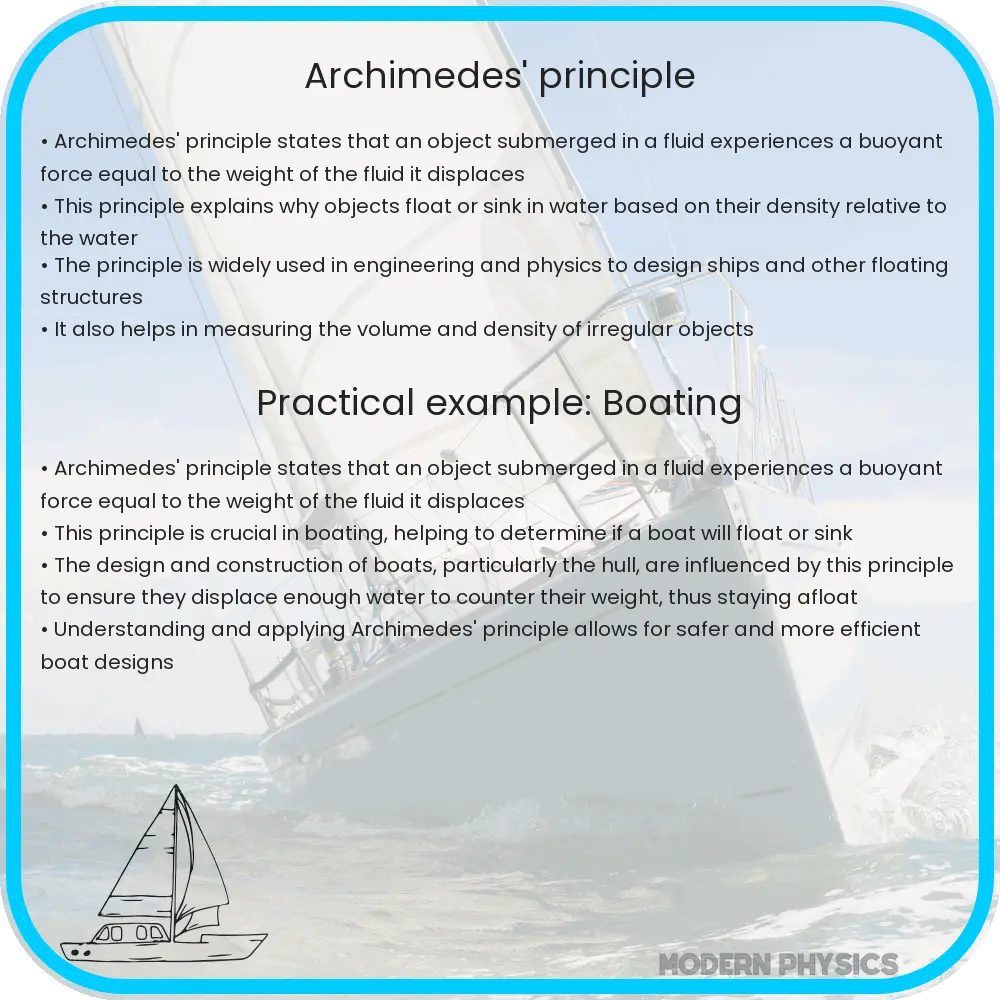Understand Archimedes’ Principle, explaining how the buoyant force helps objects float or sink by equating it to the weight of the displaced fluid.

Understanding Archimedes’ Principle and Buoyancy
Archimedes’ Principle is a fundamental concept in fluid dynamics and plays a crucial role in explaining why objects float or sink when placed in a fluid. This principle states that the buoyant force — or the upward force exerted on an object submerged in a fluid — is equal to the weight of the fluid that the object displaces. Archimedes’ Principle is essential not just in physics but also forms the basis of many engineering applications including ship design and submarine buoyancy.
The Concept of Buoyant Force
The buoyant force is a result of pressure exerted by the fluid, which varies with depth. The bottom of a submerged object experiences a greater pressure than the top, leading to a net upward force. This effectively reduces the overall weight of the submerged object, which may allow it to float if this buoyant force equals or is greater than the object’s weight. The mathematical expression for buoyant force (FB) derived from Archimedes’ Principle is:
FB = ρ * V * g
where:
- ρ (rho) is the density of the fluid,
- V is the volume of the fluid displaced by the object,
- g is the acceleration due to gravity.
It’s fascinating to note that the buoyant force does not depend on the overall depth of the object submerged, but strictly on the volume of fluid displaced.
Applications in Design and Engineering
Understanding Archimedes’ Principle is not only academically interesting but also highly practical. Engineers apply this principle in designing vessels that must float on water, such as boats and ships, and in creating stable platforms for underwater operations, such as submarines and divers’ equipment. By calculating the buoyant force, engineers can determine what shape, size, and weight distribution are needed for an object to float and maintain stability in water.
Beyond marine applications, Archimedes’ Principle assists in calculating fluid pressures and forces in various other contexts, such as the design of hydraulic systems and the study of underwater ecosystems.
Real-World Examples Illustrating Archimedes’ Principle
A simple yet powerful example of Archimedes’ Principle can be observed in the case of a balloon filled with helium. The helium in the balloon is less dense than the surrounding air. According to Archimedes’ Principle, the balloon displaces a volume of air whose weight is greater than the weight of the helium inside the balloon, thus providing it with the buoyant force necessary to float upwards.
Similarly, when an iceberg floats in ocean water, it displaces a volume of water that weighs more than the ice. Despite its massive size, the buoyant force keeps most of the iceberg submerged, with only a small fraction visible above the water surface.
In these examples, and countless others, Archimedes’ Principle provides a clear and elegant explanation of why objects either float or sink and how their buoyancy is determined. By exploring the principle further and applying it to various disciplines, one gains a deeper understanding of both theoretical physics and practical engineering principles.
Challenges in Applying Archimedes’ Principle
While Archimedes’ Principle provides a robust framework for understanding buoyancy, engineers and scientists often face challenges in applying it to complex real-world scenarios. Factors such as the shape of the object, the viscosity of the fluid, and the presence of external forces can complicate calculations. For example, in rough waters, the additional force from waves can affect the stability of ships or floating platforms, requiring advanced design strategies to ensure safety and functionality.
Educational Importance of Archimedes’ Principle
Archimedes’ Principle is not only crucial for professional applications but also serves as a fundamental teaching tool in physics and engineering education. By studying this principle, students can better understand the concepts of density, fluid mechanics, and force. Furthermore, experiments related to Archimedes’ Principle, such as determining the density of an object by submerging it in water, provide practical, hands-on learning experiences that are both informative and engaging.
These educational experiences encourage critical thinking and problem-solving skills, which are essential in both academic and real-world environments.
Conclusion
Archimedes’ Principle is a cornerstone of fluid dynamics that has deep implications in physics and engineering. By understanding how buoyant force works, how it can be calculated, and its applications and complexities, students, professionals, and enthusiasts can gain insights into a range of phenomena from floating balloons to designing massive ships. The principle not only illuminates why objects float or sink but also challenges us to apply this knowledge in innovative ways in various engineering fields. As we continue to explore and apply this ancient yet ever-relevant principle, the boundaries of science and technology are pushed further, leading to new discoveries and advancements that shape our understanding of the world.
